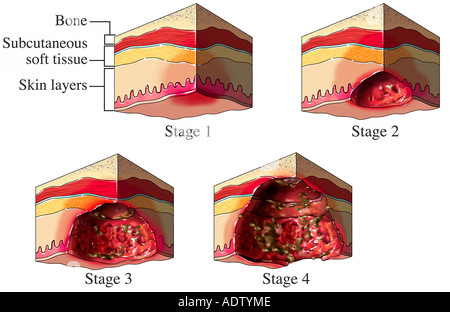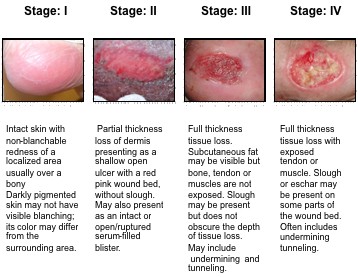
The main cause of pressure sores is sitting or lying in the same position for an extended period of time. The body’s blood supply to the tissues under the skin becomes reduced, which results in sore development. Once the blood supply is compromised, the sore can develop and become infected. While a mild pressure sore will start out as a red, painful area, it can progress to a stage that requires medical attention.
In the early stages of a pressure sore, it may be red and warm to the touch, and it may burn or be warm. In dark skin, it may be purple or blue. The sore is open, and the skin around it may be discolored or stained. If it is accompanied by any other symptoms, it is best to visit a doctor. Patients with this stage of sores should be monitored by their caregivers for at least three weeks, as treatment is not always effective.
Upon diagnosis, a doctor will examine the sore to determine its severity. The doctor will check the size and depth of the sore and examine the wound for blood and other fluid. In addition, the sore may be characterized by a foul odor. The sore may also undergo blood or urine tests to confirm its diagnosis. A tissue sample may also be taken from the sore to diagnose pressure sores. The samples are then sent to a laboratory to be examined.
Proper treatment for pressure sores is vital to its healing. With the proper care and treatment, the sore will disappear within 60 days. In some cases, the sore will be completely healed within a few days with no need for medical intervention. However, it is still important to seek medical advice immediately. If a patient is unable to find their way to a doctor, the patient should be evaluated by a specialist in order to ensure that he or she is receiving appropriate care.
The wound will be placed by a doctor or medical practitioner. The doctor will examine the ulcer to assess its size, depth, and presence of fluid. He or she will also check the ulcer for a bad smell. In more severe cases, surgical removal of pressure ulcers may be required. The health website thai-manga.com

says it’s important to take care of pressure ulcers and seek medical attention if necessary. Left untreated, an ulcer can become infected and lead to a bacterial infection.
The most effective treatment for pressure sores is prevention. It is important to prevent the spread of the ulcer. The first step is to prevent the spread of the ulcer. Change position every two hours to relieve pressure and prevent further ulceration. Simply washing the area with mild soap and water will help prevent an ulcer from developing. In addition, a saline solution should be applied to the affected area after it has cooled.
The doctor will evaluate the ulcer to determine if it is a pressure sore or a bacterial infection. The doctor will examine the ulcer for depth, texture, and fluid. If there are any signs of an ulcer, the doctor will do blood and urine tests to confirm the diagnosis. They may also do a bacterial or psoriasis test to determine the cause of the ulcer.
When a pressure sore has developed, it is essential to treat it with the proper treatment. The best way to do this is to reposition the patient every hour to avoid creating a pressure sore. The person should be confined in a bed for at least 6 hours, and this should be done every 15 minutes. The caregiver should also carefully inspect the patient’s skin for redness or other signs of infection. If there is any swelling or redness, it is time to visit the doctor.
In addition to pain medication, it is important to change positions frequently. A pressure sore will usually look like a deep crater or scrape. It may be red but is not broken and it may have changes in temperature. Eventually, the sore will turn white, and it will not fade in less than 30 minutes. If a patient has a pressure sore, it is important to remove it as soon as possible.